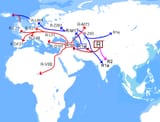Search Results
7/17/2025, 9:51:32 AM
>>17849025
>According to Underhill et al. (2014), the downstream M417 (R1a1a1) subclade diversified into Z282 (R1a1a1b1a) and Z93 (R1a1a1b2) circa 5,800 years ago "in the vicinity of Iran and Eastern Turkey". Even though R1a occurs as a Y-chromosome haplogroup among speakers of various languages such as Slavic and Indo-Iranian, the question of the origins of R1a1a is relevant to the ongoing debate concerning the urheimat of the Proto-Indo-European people, and may also be relevant to the origins of the Indus Valley civilization. R1a shows a strong correlation with Indo-European languages of Southern and Western Asia, Central and Eastern Europe and to Scandinavia being most prevalent in Eastern Europe, Central Asia, and South Asia. In Europe, Z282 is prevalent particularly while in Asia Z93 dominates. The connection between Y-DNA R-M17 and the spread of Indo-European languages was first noted by T. Zerjal and colleagues in 1999
>According to Underhill et al. (2014), the downstream M417 (R1a1a1) subclade diversified into Z282 (R1a1a1b1a) and Z93 (R1a1a1b2) circa 5,800 years ago "in the vicinity of Iran and Eastern Turkey". Even though R1a occurs as a Y-chromosome haplogroup among speakers of various languages such as Slavic and Indo-Iranian, the question of the origins of R1a1a is relevant to the ongoing debate concerning the urheimat of the Proto-Indo-European people, and may also be relevant to the origins of the Indus Valley civilization. R1a shows a strong correlation with Indo-European languages of Southern and Western Asia, Central and Eastern Europe and to Scandinavia being most prevalent in Eastern Europe, Central Asia, and South Asia. In Europe, Z282 is prevalent particularly while in Asia Z93 dominates. The connection between Y-DNA R-M17 and the spread of Indo-European languages was first noted by T. Zerjal and colleagues in 1999
Page 1
